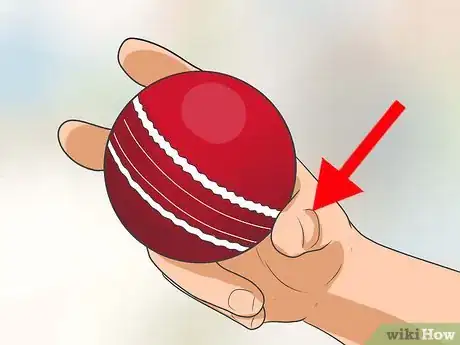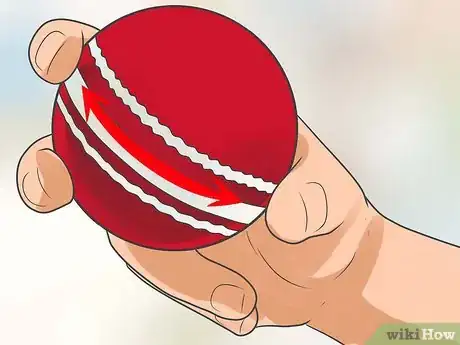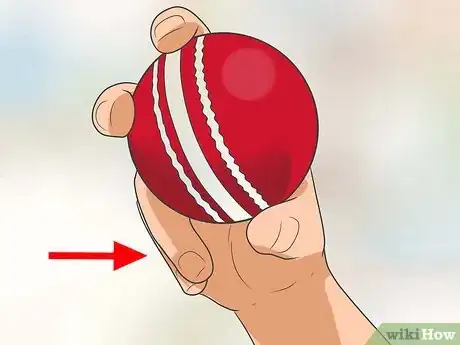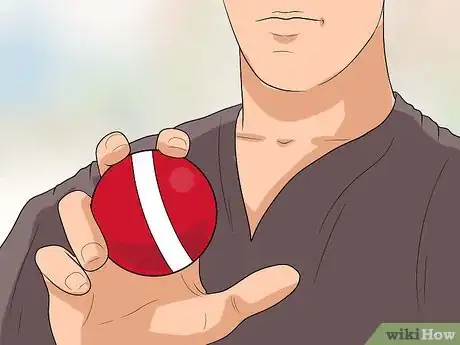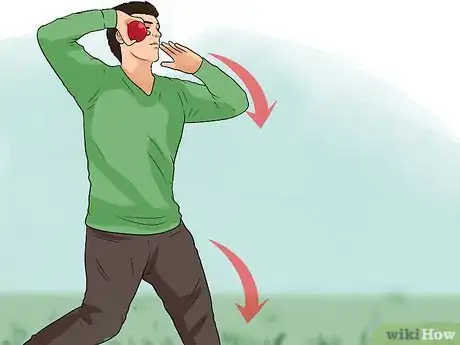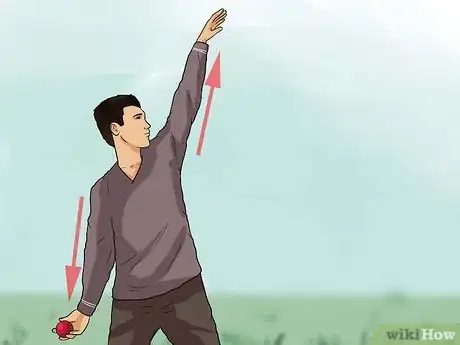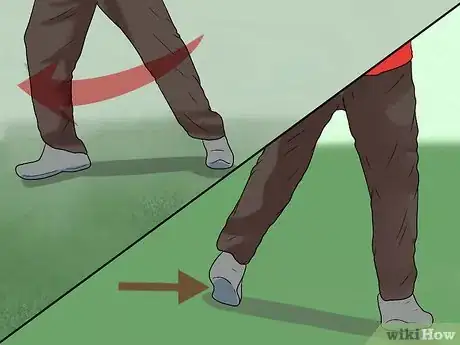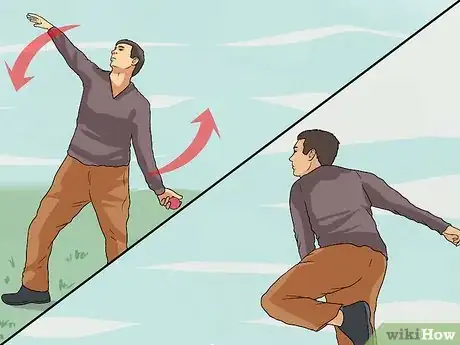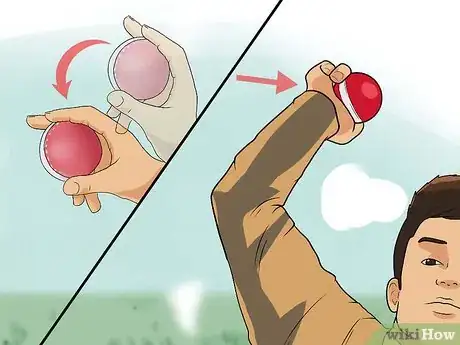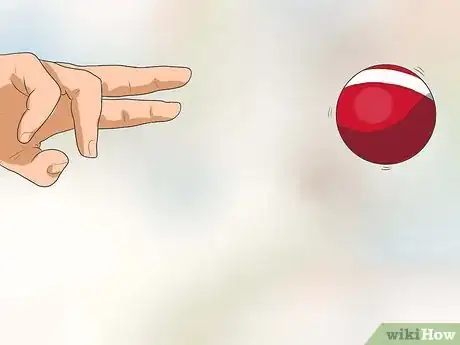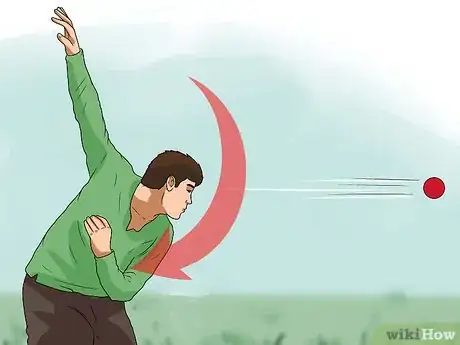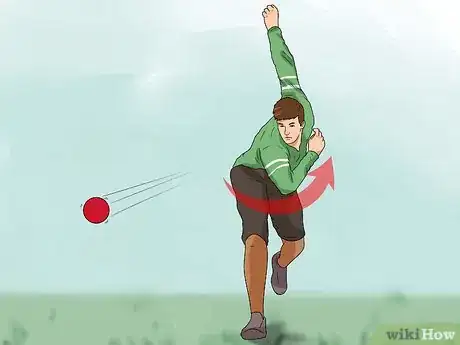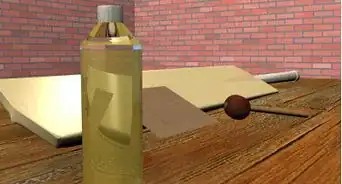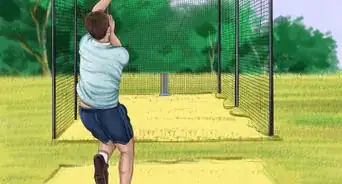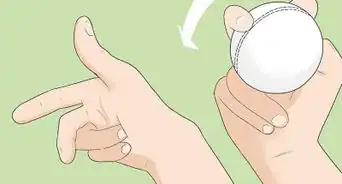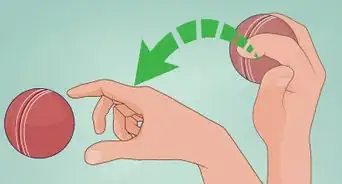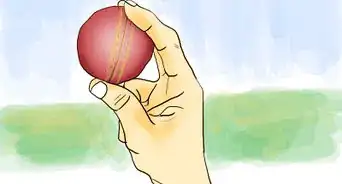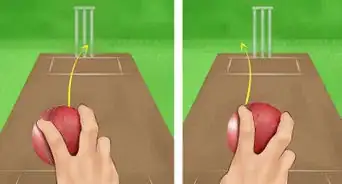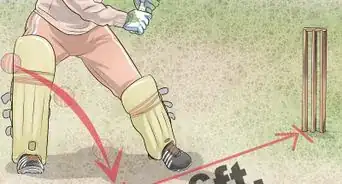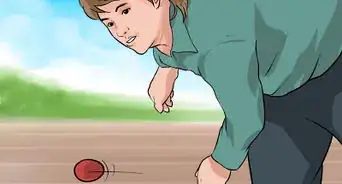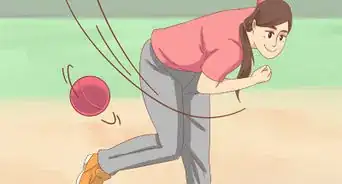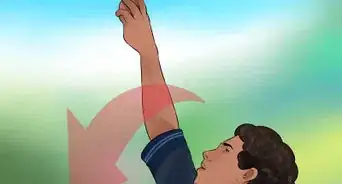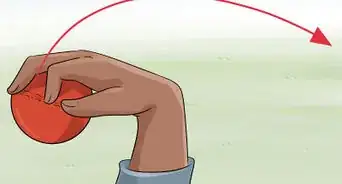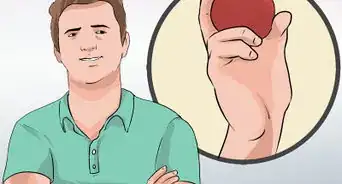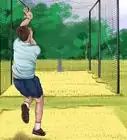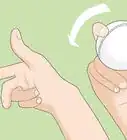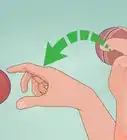This article was co-authored by Rishabh Mehan. Rishabhn Mehan is a Cricket Systems Operator in the United Kingdom. He has been coaching cricket in London since 2016, when he received his Level 2 Certificate in Coaching Young People and Adults Cricket (QCF).
wikiHow marks an article as reader-approved once it receives enough positive feedback. In this case, 84% of readers who voted found the article helpful, earning it our reader-approved status.
This article has been viewed 162,823 times.
There are many different ways to bowl a cricket ball. Some players rely on their power to generate high speed bowls, while others choose to sacrifice velocity in order to focus on creating ball movement. By changing their grip, "seam bowlers" are able to control the direction a ball bounces after it has struck the pitch, making it even more difficult for a batter to hit. After you have practiced your "run-up," try stepping-up your game by learning to seam bowl properly.
Steps
Gripping the Ball to Seam Bowl
-
1Place your thumb on the seam of the ball. A worn cricket ball will have a rough side and a smooth side, separated by a seam. Depending on velocity and rotation, this difference in surface texture will cause the ball to "swing" through the air from one side to the other.
- If bowled at velocities over 70 miles (110 km)-per-hour, the ball will swing toward the smooth side of the ball.
- If bowled below 70 miles (110 km)-per-hour, the ball will swing toward the rough side of the ball.
-
2Place your index finger on the seam, opposite your thumb. Bowled with this grip, the seam will force the ball to bounce in a certain direction. When bowled from the right hand, the ball will bounce to the bowlers left. To the right, when thrown from the left hand.
- Cricket balls that are new may have very little difference between the smooth and rough sides. This makes them less prone to "swing" through the air when bowled.
Advertisement -
3Hold the ball so that the seam is parallel to your index finger. When bowled from the right hand, the ball will strike the ground on the left side of the seam and will bounce away from a right-handed batter's "off side."
-
4Place your middle finger to the right of the seam, approximately a quarter of the way down the ball. If you keep your middle finger closer to your index finger you will be able to bowl with more velocity, however, it will be more difficult to bowl with control.
- Depending on your release, you may benefit from a different middle finger position. Experiment to see what your prefer.
-
5Wrap your ring finger and pinky into a loose fist. When you do so, there should be very little, if any, contact between the ball and these fingers.[1]
- To throw a leg cutter, place your middle finger on the seam and allow your index finger to rest on the right side of the ball.
- This slight variation in angle will cause the ball to hit the ground on the opposite side of the seam, forcing it to bounce the other direction (toward the "off side" of a right-handed batter).
Bowling and Releasing the Ball
-
1Carry the cricket ball close to your chin.[2] Bend your elbow and be sure to extend it away from the body while you make your "run-up." You should resemble a waiter or waitress carrying a platter of food.
-
2Coil your body and lean back. As you make your approach, turn from the waist so that your bowling shoulder is behind you.[3] Be sure to keep your weight back once your twist your body.
- You will generate more energy and velocity the better you can learn to shift your weight.
- If you shift too early it will affect the speed of your "run-up."
-
3Drop your elbow as you plant your bowling leg. Once you begin to drop your elbow, allow your bowling arm to fall to your side. Your weight should still be shifted and your body should still be coiled.
-
4Straighten your elbow and arm. When you plant your lead foot, straighten your elbow and allow your hand to swing down toward the ground. This will straighten your bowling arm.
- Make sure you plant your lead foot so that it points toward the batter.
-
5Shift your weight to the lead leg.[4] Allow your body to uncoil as you shift your weight forward to your lead foot.
-
6Thrust your bowling shoulder forward. When you plant your lead foot, imagine that your body is a whip and begin to thrust your shoulder forward as soon as you feel your momentum begin to carry you.
- Shifting your weight properly will generate momentum.
-
7Swing your arm like a windmill. Keeping your elbow straight, rotate your arm behind you and swing it over-the-top toward the batter.
- Throws are illegal in cricket. If you bend your arm and lead with the elbow it will count as a throw.
- The shoulder must be the body part through which power is generated.
- Umpires will call a "no ball" when a player throws or "chucks."
-
8Snap your wrist forward just before you release the ball.[5] This will not only add a little more velocity to the bowl, but will also create the proper angle of release.
- Snapping your wrist also prevents you from releasing the ball too late, which is often times the result of a player compensating for an improper angle of release.
- Overtime, a late release can result in excessive stress and/or injury to the bowling shoulder.
-
9Release the ball. When your hand reaches the peak of your delivery arc, release the ball and allow it to roll off the tips of your index and middle fingers.[6] Remember to keep your arm straight so that you do not suffer any elbow injuries, or illegally "throw" the ball.
- Because of its weight, a cricket ball can cause injury to the elbow if it is "thrown" or bowled incorrectly.
-
10Follow through properly. After your release the ball, fold your bowling arm into your chest and relax your elbow.[7]
-
11Bend your elbow. As you bend your elbow, relax your forearm and hand, allowing your arm to wrap around your waist or stomach.
Expert Q&A
Did you know you can get expert answers for this article?
Unlock expert answers by supporting wikiHow
-
QuestionIf I am a wrong footed bowler, will this affect my speed?
 Rishabh MehanRishabhn Mehan is a Cricket Systems Operator in the United Kingdom. He has been coaching cricket in London since 2016, when he received his Level 2 Certificate in Coaching Young People and Adults Cricket (QCF).
Rishabh MehanRishabhn Mehan is a Cricket Systems Operator in the United Kingdom. He has been coaching cricket in London since 2016, when he received his Level 2 Certificate in Coaching Young People and Adults Cricket (QCF).
Cricket Coach
-
QuestionHow can I bowl where I want?
 Rishabh MehanRishabhn Mehan is a Cricket Systems Operator in the United Kingdom. He has been coaching cricket in London since 2016, when he received his Level 2 Certificate in Coaching Young People and Adults Cricket (QCF).
Rishabh MehanRishabhn Mehan is a Cricket Systems Operator in the United Kingdom. He has been coaching cricket in London since 2016, when he received his Level 2 Certificate in Coaching Young People and Adults Cricket (QCF).
Cricket Coach
-
QuestionHow can I increase the accuracy of hitting the wickets?
 Community AnswerFirst, point your non-bowling hand towards the wickets, then bowl the ball and swing your dominant knee (on the same side as your bowling hand) towards the wickets and follow through.
Community AnswerFirst, point your non-bowling hand towards the wickets, then bowl the ball and swing your dominant knee (on the same side as your bowling hand) towards the wickets and follow through.
Warnings
- Be careful not to develop a release that is "late." With time, a late release can cause stress and injury to the bowling shoulder.⧼thumbs_response⧽
- Be sure you do not "throw" the cricket ball, or lead with the elbow as your bowl. Doing so can cause harm to the elbow and will cause a "No Ball" to be called.⧼thumbs_response⧽
References
- ↑ http://news.bbc.co.uk/sportacademy/hi/sa/cricket/skills/newsid_3230000/3230563.stm
- ↑ http://news.bbc.co.uk/sport2/hi/cricket/skills/4172964.stm
- ↑ http://news.bbc.co.uk/sport2/hi/cricket/skills/4172964.stm
- ↑ http://www.pitchvision.com/4-simple-ways-to-be-a-better-fast-bowler
- ↑ http://www.pitchvision.com/4-simple-ways-to-be-a-better-fast-bowler
- ↑ http://news.bbc.co.uk/sport2/hi/cricket/skills/4172964.stm
- ↑ http://news.bbc.co.uk/sport2/hi/cricket/skills/4172964.stm
About This Article
To bowl in cricket, start by holding the ball close to your chin. Then, lean back and twist from the waist so your bowling shoulder is behind you. Next, shift your weight and your bowling shoulder forward, and swing your bowling arm like a windmill. Snap your wrist forward just before releasing the ball, then fold your bowling arm into your chest and relax your elbow. For tips from our Cricket reviewer on how to grip the ball for your best bowl, keep reading!
